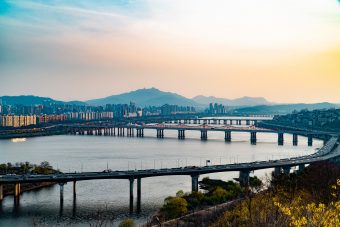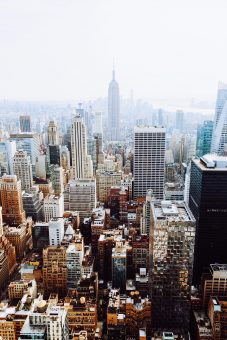
Around the world, more than 90 percent of people breathe in air that the World Health Organization (WHO) considers potentially harmful.
While the source of air pollution varies – some come from vehicle emissions, some from power plants, some from crop burning – the outcome is the same: airborne contaminants are a dire threat to human health.
Every year, they cause about 7 million premature deaths from ailments such as stroke, heart disease, and lung cancer. Many air pollutants, like carbon dioxide, are also potent greenhouse gases that feed climate change.
That has made it all the more important for cities to improve their air quality, said Maria Neira, the Director of Environment, Climate Change and Health with the WHO.
“We need to reconsider the way we consume resources and the way our cities are built. This is at the heart of the future development of our society.”
Many urban areas are beginning to do exactly that. From implementing ultra-low emissions zones to banning cars, here are five cities that are taking innovative steps to clean their air.
Paris, France
The French capital has barred the most polluting vehicles from entering the city centre, banished cars from the Seine River quayside and reclaimed road space for trees and pedestrians.
With the onset of the COVID-19 pandemic, city officials recorded a significant drop in nitrogen dioxide — a pollutant emitted by vehicles; particulate matter— a potential cause of respiratory disease; and carbon dioxide. To solidify those gains, and give coronavirus-wary residents an alternative to driving, the city also expanded its network of bike lanes. Now, the mayor of Paris, Anne Hidalgo, is aiming to transform Paris into “a walkable city”, where the needs of residents can be met within a 15-minute stroll.
“Air pollution has been improved a lot in Paris,” said Karine Leger, director-general of Airparif, an organization that monitors air quality. “Since there is a link between COVID-19 and air pollution, improving air quality will also be a focal point in the attractiveness of the city for both tourism and economic activities in coming years.”
More:
Seoul, Republic of Korea
Korea has made headlines for its state-of-the-art campaign against air pollution. 5G-enabled autonomous robots scan industrial complexes to monitor air quality, while a satellite monitoring system offers real-time air quality data to the public.
City leaders have also announced plans to create the first “wind path forest” in Seoul, planting trees close together along rivers and roads to channel air into the city centre. The forest is expected to absorb particulate matter and bathe downtown Seoul in cooling breezes. The city has already transformed an abandoned viaduct above Seoul’s main railway station into an elevated arboretum.
By 2030 it hopes to increase green space by 30 percent and make sustainable modes of transport, such as walking, biking, and public transportation, account for 80 percent of trips.

New York City, United States of America
The concrete jungle of New York City is going green. In an effort to improve air quality, New York Governor Andrew Cuomo announced USD 1.4 billion in funding for renewable energy projects, including solar plants and wind farms, which will power 430,000 homes. It is the largest single commitment to renewable energy by a state in American history. The projects, which are expected to be in use by 2022, will reduce carbon emissions by 1.6 million metric tons, equivalent to taking 340,000 cars off the road.
In another first for the country, a congestion charge will be introduced for drivers in the Manhattan area. Cars passing by checkpoints in the city’s Midtown area will be charged USD 10-15. As well as aiming to reduce emissions by keeping cars off the road, the initiative is expected to raise USD 15 billion that will be reinvested in the public transport system.
Bogota, Colombia
With the onset of the COVID-19 lockdown, Bogota— like other cities— saw a dramatic drop in air pollution. Encouraged by this, the city has set out a series of initiatives to try to clean up its transport sector permanently, which Mayor Claudia López says is responsible for 70 percent of Bogotá’s air pollution. The city has plans to impose strict emissions standards on trucks and other heavy-polluting vehicles; develop a fully electric metro rail system capable of transporting its 8 million residents, and add an additional 60 kilometres to the existing 550 km bicycle paths. Since March 2020, the city has added 80 km, which the mayor says are being used constantly.
“We’re going to take advantage of the fact that the pandemic allowed us to speed up this agenda of clean air and pursue different modes of clean and green transportation,” said López.
Accra, Ghana
Accra, Ghana, became the first African city to join the BreatheLife campaign, a joint campaign by WHO, UN Environment Programme, World Bank and the Climate & Clean Air Coalition, to mobilize cities to act on air pollution.
The city is also part of the pilot of the WHO-Urban Health Initiative. Through it, the Ghana Health Services and the WHO work to encourage a switch from coal-based cookstoves to ones powered by gas or electricity in order to protect mothers and children from household smoke. They also run a sensitization initiative on the health impact of burning waste. According to WHO, if all open waste burning was stopped by 2030, 120 premature deaths could be avoided yearly.
“In our part of the world, air pollution is not prioritized as a health concern – even in the way we cook,” said the Mayor of Accra, Mohammed Adjei Sowah. “But the statistics are so staggering that we have to wake people up to take action. We have to talk about it loudly so that it becomes part of our discourse in the urban political space.”
Source: UNEP



